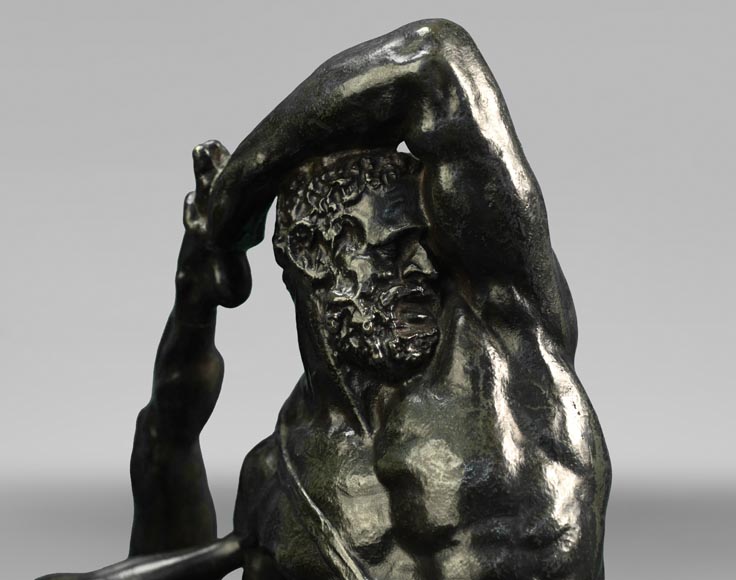Style romanticism / Ref.13372
Antonio CANOVA (after), INGÉ and SOYER (attributed to), Clock “Hercules and Lichas”, circa 1840
Dimensions
Width 16'' ⅞ 43cm
Height 24'' ⅜ 62cm
Depth: 9'' 23cm
Origin:
France, 19th century
Antonio Canova (after), Ingé and Soyer (attributed to), Hercules and Lichas Clock, circa 1840
This clock, made around 1840, is attributed to the founders Ingé and Soyer. The sculpture was executed after Hercules and Lichas (1795-1815), a marble by Antonio Canova (1757-1822) preserved at the National Gallery of Modern and Contemporary Art in Rome.
Ingé and Soyer partnered from 1831. They notably participated in the 1834 Exhibition of Industrial Products, where they exhibited among other works “the group of Canova’s Hercules” (Baron Charles Dupin, Report of the Central Jury on the Products of French Industry Exhibited in 1834, Paris, 1836, vol. 3, p. 140), which is found on our clock. During the exhibition, they received a silver medal for “the excellence of [their] production, remarkable for the perfection of the sand casting and the chiseling work” (Catherine Chevillot and Laure de Margerie, Sculpture in the 19th Century: Essays for Anne Pingeot, 2008, Éditions Nicolas Chaudun).
The subject of the sculpture is drawn from chapter IX of Ovid’s Metamorphoses. Lichas had been tasked by Deianira to deliver Nessus’s tunic to her husband. However, when Hercules felt his body being consumed, thinking that he had betrayed him, he grabbed him by the foot and threw him into the Euboean Sea. The presence of the rocks at the base of the clock recalls that, according to Ovid, Lichas then transformed into a rock. The snake encircling the clock face aligns with the Herculean theme, echoing Hercules’ first labor of strangling the snakes placed in his cradle by the goddess Hera.
Canova’s marble sculpture, created in 1795, enjoyed great popularity in France. The sculptor had indeed sent it to Quatremère de Quincy, one of the great advocates of his art in France, who probably contributed to the dissemination of this model. It was subsequently cast by Ingé and Soyer, who also adapted it for our clock.
This rock and the clock face were identically reused for another of their clocks, called “Saint Michael the Archangel, Conqueror of Satan, Announcing the Reign of God”, housed in the Louvre. This clock is topped with a sculpture by Jehan Duseigneur. It was signed by Duseigneur and by the founders Ingé and Soyer, providing the final clue linking our clock to their work.
Informations
Price: on request
Recommended for you :
Dimensions:
Width: 19
Height: 16
Depth: 10
Dimensions:
Width: 28
Height: 90
Diameter: 21
Dimensions:
Width: 31
Height: 56
Depth: 26
Dimensions:
Width: 19
Height: 17
Depth: 11
Dimensions:
Width: 44
Height: 48
Depth: 18
Dimensions:
Width: 27
Height: 67
Depth: 23
Dimensions:
Width: 27
Height: 44
Dimensions:
Width: 22
Height: 53
Depth: 19
Dimensions:
Width: 31
Height: 45
Depth: 21
Dimensions:
Width: 49
Height: 75
Depth: 16
Dimensions:
Width: 28
Height: 57
Depth: 13
Dimensions:
Width: 35
Height: 42
Depth: 169



























